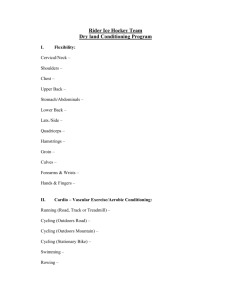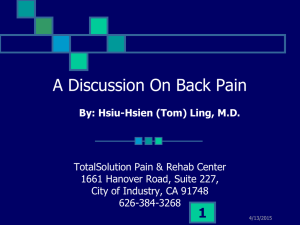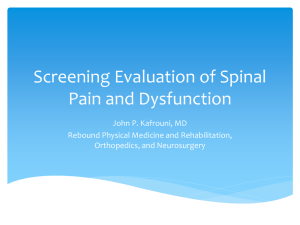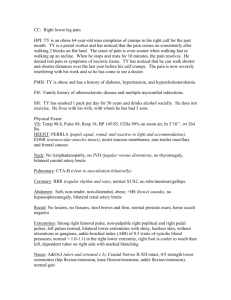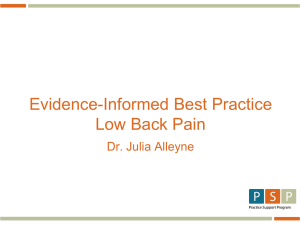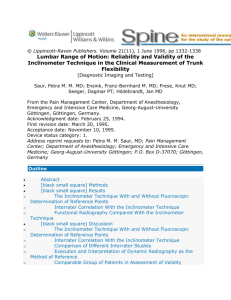Lumbar Evaluation Form
advertisement
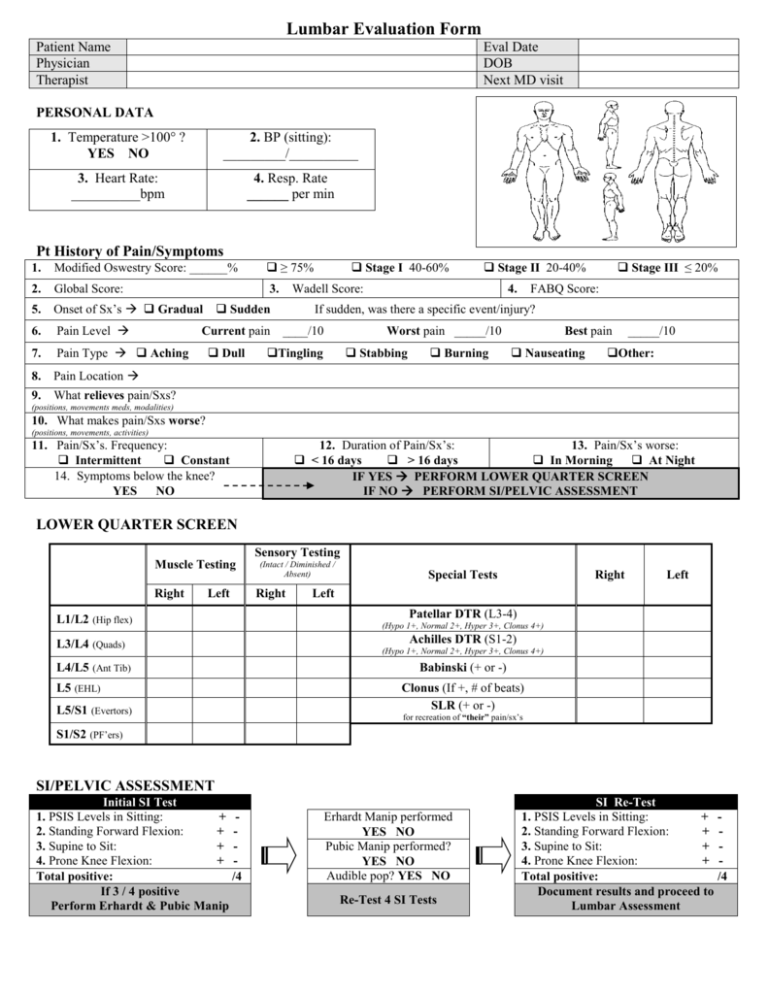
Lumbar Evaluation Form Patient Name Physician Therapist Eval Date DOB Next MD visit PERSONAL DATA 1. Temperature >100° ? YES NO 2. BP (sitting): _________/__________ 3. Heart Rate: __________bpm 4. Resp. Rate ______ per min Pt History of Pain/Symptoms 1. Modified Oswestry Score: ______% ≥ 75% 2. Global Score: 3. 5. Onset of Sx’s Gradual 6. Pain Level 7. Pain Type Aching 8. Pain Location 9. What relieves pain/Sxs? Dull Stage II 20-40% Wadell Score: Sudden Current pain Stage I 40-60% 4. Stage III ≤ 20% FABQ Score: If sudden, was there a specific event/injury? ____/10 Worst pain _____/10 Tingling Stabbing Burning Best pain Nauseating _____/10 Other: (positions, movements meds, modalities) 10. What makes pain/Sxs worse? (positions, movements, activities) 11. Pain/Sx’s. Frequency: Intermittent Constant 14. Symptoms below the knee? YES NO 12. Duration of Pain/Sx’s: 13. Pain/Sx’s worse: < 16 days > 16 days In Morning At Night IF YES PERFORM LOWER QUARTER SCREEN IF NO PERFORM SI/PELVIC ASSESSMENT LOWER QUARTER SCREEN Sensory Testing Muscle Testing Right Left L1/L2 (Hip flex) L3/L4 (Quads) L4/L5 (Ant Tib) L5 (EHL) L5/S1 (Evertors) (Intact / Diminished / Absent) Right Special Tests Right Left Left Patellar DTR (L3-4) (Hypo 1+, Normal 2+, Hyper 3+, Clonus 4+) Achilles DTR (S1-2) (Hypo 1+, Normal 2+, Hyper 3+, Clonus 4+) Babinski (+ or -) Clonus (If +, # of beats) SLR (+ or -) for recreation of “their” pain/sx’s S1/S2 (PF’ers) SI/PELVIC ASSESSMENT Initial SI Test 1. PSIS Levels in Sitting: + 2. Standing Forward Flexion: + 3. Supine to Sit: + 4. Prone Knee Flexion: + Total positive: /4 If 3 / 4 positive Perform Erhardt & Pubic Manip Erhardt Manip performed YES NO Pubic Manip performed? YES NO Audible pop? YES NO Re-Test 4 SI Tests SI Re-Test 1. PSIS Levels in Sitting: + 2. Standing Forward Flexion: + 3. Supine to Sit: + 4. Prone Knee Flexion: + Total positive: /4 Document results and proceed to Lumbar Assessment LUMBAR ASSESSMENT For single movement and repeated movement testing, use the following definitions Worsen (peripheralizes): Parasthesia is produced or pt’s pain/parasthesia moves distally from lumbar spine once movements stop(not only during movements) Improves (centralizes): Parasthesia or pain is abolished or moves from periphery toward lumbar spine once movements stop (not only during movements) Status Quo: Patient’s symptoms may increase or decrease in intensity but do not centralize or peripheralize Single Movement Testing: Right SB’ing 1. _____ cm (distance right middle finger to ground in cm) Left SB’ing 2. If symmetrical SB’ing (capsular) Central issue If asymmetrical SB’ing (non-capsular) Unilateral issue _____ cm (distance right middle finger to ground in cm) Once you’ve identified capsular vs. non-capsular Proceed to Repeated Movement Testing Repeated Movement Testing: 3. Lateral Shift? R L None 4. (pt to SB each dirction at least 10x’s) Effect on Pain/Sx’s: Improve Status Quo Worsen Traction Lateral- Syndrome Shift Syndrome Active Pelvic Translocation Traction Flexion 5. (pt to flex forward at least 10x’s) Effect on Pain/Sx’s: Worsen Improve Status Quo General General (capsular) (capsular) / Specific (non-capsular) Mobilization Syndrome General – Passive Pelvic Translocation & General Mobs Specific – Opening/Closing Manip/Mob Traction Flexion Syndrome Syndrome Traction Active Flexion Exercises Specific (non-capsular) Mobilization Syndrome Extension (pt to extend backward at least 10x’s) Effect on Pain/Sx’s: Worsen Improve Status Quo General Traction Extension Syndrome Syndrome Traction Active Extension Exercises General Mobs (capsular) Specific Mobs (non-capsular) (capsular) Specific (non-capsular) Mobilization Syndrome General Mobs (capsular) Specific Mobs (non-capsular) ROM Range Limited By (Full or % Limited) (Pain, mm tightness, etc) Deviations? Flexion Extension R SB’ing L SB’ing R Rotation L Rotation JT MOBILITY Level Central PA L Unilateral R Unilateral (Hypo, N, Hyper) (Hypo, N, Hyper) (Hypo, N, Hyper) Pain w/ assessment? Does it recreate “their” pain? T12 L1 L2 L3 L4 L5 Indication for Lumbar Manipulation (besides (+) 3/4 SI Tests) 1. Duration of current episode of low back pain is < 16 days in duration (question No. 11) 2. Pain/Sx’s distal to knee (question No. 13) 3. FABQ Score < 19 (question No. 4) 4. > 1 hypomobile lumbar segment (Jt Mobility section) 5. Hip IR of at least one hip > 350 If you answer YES on 4 / 5 Perform Erhardt and pubic manipulation YES YES YES YES YES NO NO NO NO NO YES YES YES YES NO NO NO NO Indication for Success with Stabilization Training 1. Age <40 years old 2. Average SLR >910 3. Positive prone instability test 4. Aberrant movement (including lumbar catch) during lumbar ROM If you answer YES on 3 / 4 Perform abdominal and lower back stability exercises

